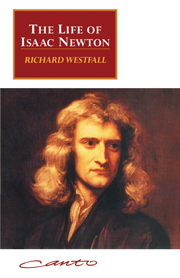Book contents
- Frontmatter
- Dedication
- Contents
- Preface
- Acknowledgments
- A Note About Dates
- Plates
- 1 A Sober, Silent, Thinking Lad
- 2 The Solitary Scholar
- 3 Anni Mirabiles
- 4 Lucasian Professor
- 5 Publication and Crisis
- 6 Rebellion
- 7 Years of Silence
- 8 Principia
- 9 Revolution
- 10 The Mint
- 11 President of the Royal Society
- 12 The Priority Dispute
- 13 Years of Decline
- Bibliographical Essay
- Index
11 - President of the Royal Society
Published online by Cambridge University Press: 05 September 2013
- Frontmatter
- Dedication
- Contents
- Preface
- Acknowledgments
- A Note About Dates
- Plates
- 1 A Sober, Silent, Thinking Lad
- 2 The Solitary Scholar
- 3 Anni Mirabiles
- 4 Lucasian Professor
- 5 Publication and Crisis
- 6 Rebellion
- 7 Years of Silence
- 8 Principia
- 9 Revolution
- 10 The Mint
- 11 President of the Royal Society
- 12 The Priority Dispute
- 13 Years of Decline
- Bibliographical Essay
- Index
Summary
THE ROYAL SOCIETY, to which Newton had dedicated his Principia in 1687 only to ignore it steadfastly when he moved to London, stood at a low ebb during the early years of his residence in the capital city. Membership, which had reached more than two hundred in the early years of the 1670s, now scarcely numbered more than half that figure, and meetings, given over mostly to miscellaneous chitchat devoid of serious scientific interest, suggested little of the interests that had brought the society together forty years earlier. The presence of Robert Hooke, not Newton's favorite natural philosopher, may well have determined his absence from the weekly meetings. Hooke was usually there. When Newton put in one of his rare appearances to show a “new instrument contrived by him,” a sextant, which would be useful in navigation, Hooke reminded him of past antipathies by claiming that he had invented it more than thirty years before. Hooke's death in March 1703 removed an obstacle and prepared the way for Newton's election as president at the next annual meeting on St. Andrew's Day, 30 November.
Obscurity covers the background to Newton's election. Spontaneous expressions of popular will did not govern the selection of officers of the Royal Society. In all probability, Dr. Hans Sloane, the secretary, made the prior arrangements. At the meeting on 30 November something nearly went awry. Newton was not a political leader who had only to be proposed to be elected. Only twenty-two of the thirty members present voted to place him on the council, a necessary preliminary to election as president. Once elected to the council, he still received only twenty-four votes for president.
- Type
- Chapter
- Information
- The Life of Isaac Newton , pp. 247 - 272Publisher: Cambridge University PressPrint publication year: 1994

